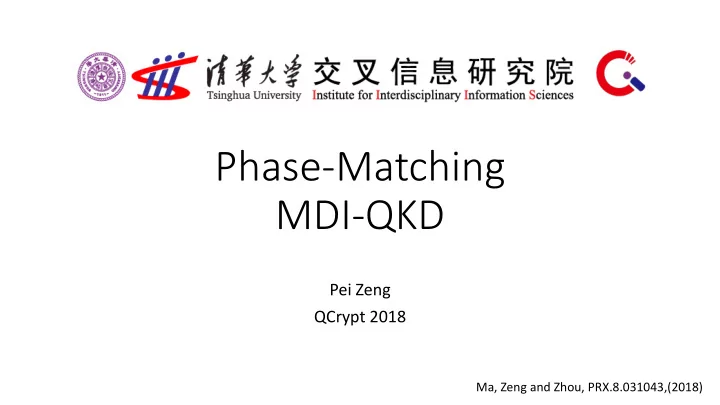

Phase-Matching MDI-QKD Pei Zeng QCrypt 2018 Ma, Zeng and Zhou, PRX.8.031043,(2018)
Outline • Motivation & background • Protocol & security • Practical issues & simulation • Summary & outlook
Motivation & Background
? 𝑆 𝜃 𝜃 Alice Bob
𝑃(𝜃 2 ) = 𝑆 𝜃 Alice Bob ±𝛽 , ±𝑗𝛽 Huttner, Imoto, Gisin and Mor, PRA 51(3):1863 (1995) Lo and Preskill, QIC, 7, 431-458 (2007)
𝑃(𝜃 2 ) = 𝑆 𝑃(𝜃) 𝜃 Alice Bob ±𝛽 , ±𝑗𝛽 Decoy state method Lo, Ma and Chen, PRL 94, 230504 (2005)
𝑆 = 𝑃(𝜃) • Secret key capacity (SKC) bound • For all point-to-point QKD models 𝑆 ≤ − log 2 (1 − 𝜃) • Protocols beyond SKC model? • Alice and Bob both are sources/detectors Takeoka, Guha and Wilde, Nat. Comm. 5, 5235 (2014) Pirandola, Laurenza, Ottaviani, and Banchi, Nat. Comm. 8, 15043 (2017)
𝑆 = 𝑃(𝜃) ? E.g. BBM92 protocol Eve 𝜃 𝜃 00 + 11 Alice Bob 2 Coincident detection ⇒ 𝑆 = 𝑃 𝜃 = 𝑃(𝜃) Bennett, Brassard, and Mermin, PRL 68, 557 (1992)
𝑆 = 𝑃(𝜃) ? E.g. Polarization encoding MDI-QKD protocol Eve 𝜃 𝜃 Alice Bob 0 , 1 , |±⟩ 0 , 1 , |±⟩ 2 Coincident detection ⇒ 𝑆 = 𝑃 𝜃 = 𝑃(𝜃) Lo, Curty and Qi, PRL 108, 130503 (2012)
𝑆 = 𝑃(𝜃) ? E.g. “MDI - B92” protocol; Phase-matching type protocol • Unambiguous State Discrimination attack • 𝑄 𝑡𝑣𝑑 ∼ 𝑃(𝜈) 2 • 𝜈 ≤ 𝑃( 𝜃) , 𝑆 = 𝑃 𝜃 = 𝑃(𝜃) 𝜈 , − 𝜈 𝜈 , − 𝜈 Ferenczi, Ph.D Thesis, Lutkenhaus ’ group (2013)
𝑆 > 𝑃(𝜃) ! Twin-field QKD • Point out the potential of 𝑆 > 𝑃(𝜃) • BB84 type encoding, ±𝛽 , ±𝑗𝛽 • Introduce the decoy state method Lucamarini, Yuan, Dynes and Shields, Nature. 2018, 557(7705):400-403
Protocol & security
Phase-matching (MDI-)QKD 𝜈𝑓 𝑗 𝜚 𝑏 +𝜌𝜆 𝑏 𝜈𝑓 𝑗 𝜚 𝑐 +𝜌𝜆 𝑐 𝐵 𝐶 • Extension of “MDI - B92” protocol • Phase-reference should be matched • Detection matches the phases: Eve’s detection create a correlation between 𝜆 𝑏 , 𝜆 𝑐
Random phase PM protocol: Entanglement-based view • Consider the post-selected signals with the same phase 𝜚 𝑎 − 𝐼 𝐹 𝜈 • 𝐿 = 1 − 𝐼 𝐹 𝜈 𝑌 • Key point: estimate the phase error 𝐹 𝜈 𝑌 Lo and Chau, Science 283, 2050 (1999) Shor and Preskill, PRL 85, 441 (2000)
Ancillary protocol, decoy state • For 𝑙 photon number input: 𝑎 = 𝑓 𝑙 𝑌 • 𝑓 𝑙 if 𝑙 is odd 𝑎 = 1 − 𝑓 𝑙 𝑌 • 𝑓 𝑙 if 𝑙 is even 𝑎 , 𝑍 𝑎 • Decoy state to estimate 𝑓 𝑙 𝑙 • Estimate the overall phase error rate 𝑌 = 𝑌 𝐹 𝜈 𝑟 𝑙 𝑓 𝑙 𝑙
Key rate and parameter estimation 𝑎 − 𝐼 𝐹 𝜈 𝑌 • 𝐿 = 𝑅 𝜈 1 − 𝐼 𝐹 𝜈 • 𝑅 𝜈 = 𝑃( 𝜃) • 𝑅 𝜈 = σ 𝑙 𝑞 𝑙 𝑍 𝑙 𝑎 = σ 𝑙 𝑟 𝑙 𝑓 𝑙 𝑌 ≤ 𝑟 0 𝑓 0 + 𝑟 1 𝑓 1 𝑎 + 𝑟 3 𝑓 3 𝑎 + (1 − 𝑟 0 − 𝑟 1 − 𝑟 3 ) 𝑎 • 𝐹 𝜈 • 𝐹 𝜈 𝑌 -- overall phase error rate; • 𝐹 𝜈 𝑌 = σ 𝑙 𝑟 𝑙 𝑓 𝑙 𝑌 • 𝐹 𝜈 • Phase announcement is critical, not commute with photon number measurement • Photon number channel model invalid: collective BS attack • Core observation: overall phase error rate is the same
Practical issues & simulation
Practical issues • Infinitesimal post-selection condition • Introduce phase slices • No effect on the security, just introduce intrinsic errors • Continuous phase randomization: hard • Discrete phase randomization is enough • Phase locking requirement • Alice and Bob can estimate the phase reference deviation of each round • Post-selection(Sifting) based on estimated phase difference; no feedback • Only requirement: the phase cannot fluctuate too quickly
Performance of PM protocol • Consider all the practical factor: • Dark count: 8 ∗ 10 −8 • Detection efficiency: 14.5% • Sifting factor: 1/8 • Misalignment: ~1.5% • Error correction efficiency: 1.15 2 𝑎 − 𝐼 𝐹 𝜈 𝑌 • 𝐿 = 𝑁 𝑅 𝜈 1 − 𝑔𝐼 𝐹 𝜈 • Break the linear bound! Ma, Zeng and Zhou, PRX.8.031043,(2018)
Summary & outlook
Summary 𝑆 = 𝑃( 𝜃)
Outlook 𝑆 = 𝑃 𝜃 ?
Thanks! • Xiongfeng Ma: xma@tsinghua.edu.cn • Pei Zeng: qubitpei@gmail.com • Hongyi Zhou: zhouhy14@mails.tsinghua.edu.cn Xiongfeng Group, Center for Quantum Information, Tsinghua University
Recommend
More recommend